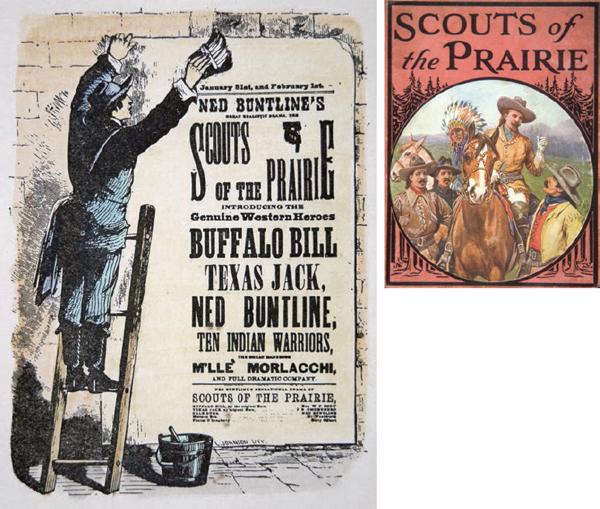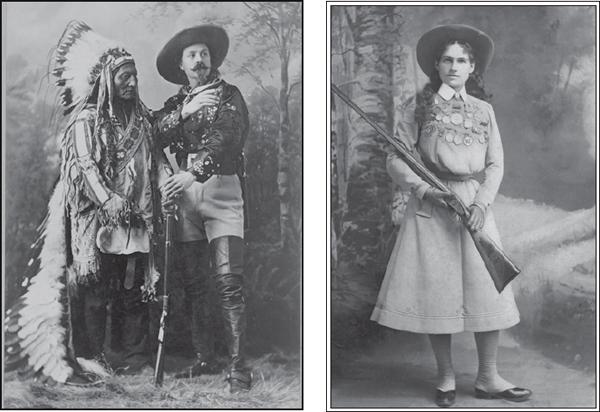Bill O'Reilly's Legends and Lies (28 page)
Read Bill O'Reilly's Legends and Lies Online
Authors: David Fisher

Although popular fiction plots of the day often turned on fortuitous and unexpected meetings, such was exactly the case when Bill Cody met Edward Judson in 1869. Cody had been ordered to scout for an expedition hunting a band of Sioux that had attacked Union Pacific workers near O’Fallon’s Station in Nebraska and was told Judson would be riding along. Judson turned out to be an extraordinarily eccentric character, at the time becoming quite famous under the pseudonym Ned Buntline. Buntline was a writer, journalist, and publicist, a man known for delivering passionate temperance lectures—after which he would often go out and celebrate by getting drunk. It was Buntline who introduced Bill Cody to the art of selling the West and introduced Buffalo Bill to the world. Buntline understood that Americans were thrilled by the hair-raising stories of cowboys and Indians in the Old West and set out to profit from it. After meeting Cody and hearing his stories, Buntline wrote an adventure serial for Street and Smith’s
New York Weekly
entitled “Buffalo Bill, the King of the Border Men.” The popularity of that story convinced Buntline to write and publish the first of dozens of dime novels featuring Cody’s exploits:
Buffalo Bill, The Scouts of the Plains; or, Red Deviltry as It Is.
These action-packed adventure stories of a heroic Buffalo Bill defending his life and his honor against the most evil villains of the West became tremendously popular, turning Cody into a national hero. Taking advantage of this fame, Buntline convinced Cody to star in a rousing play he had written and was producing entitled
The Scouts of the Plains.
“There’s money in it,” Cody reported being told by Buntline, “and you will prove a big card, as your character is a novelty on stage.”

Ned Buntline’s 1872 show set the stage for the creation of the western myth. Although the Chicago
Times
called it a “combination of incongruous drama, execrable acting, renowned performers, mixed audience, intolerable stench, scalping, blood and thunder,” audiences loved it.
Cody decided, “A fortune is what we’re after, and we’ll at least give the wheel a turn or two to see what luck we have.” Starring Cody, Texas Jack Omohundro, a young Italian actress playing an Indian maiden, and eventually Wild Bill Hickok, the play toured eastern cities for years. As Cody described it, “[T]here were between forty and fifty ‘supers’ dressed as Indians…. We blazed away at each other with blank cartridges … We would kill them all off in one act, but they would come up again ready for business in the next.”
What the play lacked in dramatic conventions, it made up for in exuberance. “An extraordinary production,” wrote the
Boston Journal,
“with more wild Indians, scalping knives
and gun powder to the square inch than any drama ever before heard of.” The
Norfolk Journal
reported that “one of the largest audiences ever assembled within [Opera House] walls” saw “the crowning piece of the night … which excited juveniles to the wildest demonstrations of delight … whenever Texas Jack and Buffalo Bill appeared on stage the audience cheered …”

Buffalo Bill was already America’s first matinee idol when he added to his legend by killing Cheyenne chief Yellow Hair and claiming, “The first scalp for Custer!”
A different type of entertainment apparently was taking place backstage as men accustomed to a rougher type of living adjusted to show business. There were stories of all-night card games, brawls, wrecked furniture, and the occasional arrest. But for Cody, the lines between reality and theater truly became blurred when the army called him into service to scout for the Fifth Cavalry in the Sioux Wars after his friend, Colonel George Custer, was killed and his troops massacred at Little Bighorn.
A legendary story Bill Cody told in his memoirs perfectly illustrated how he straddled the line between real life and entertainment: By mid-July 1876, the Fifth Cavalry had been chasing the Cheyennes for more than a week, intent on avenging Custer’s death. When Cody awoke on the morning of July 17, he sensed there would be a fight that day. So he dressed for the battle carefully, putting on the scouting costume he wore in Buntline’s show: a red silk shirt with billowing sleeves and decorative silver buttons, flared black pants with gold cross braiding embroidered on the thighs and held in place by a broad leather belt with a large rectangular metal buckle, a well-worn leather vest, comfortable boots, and a sombrero-like brown hat with the brim pushed up in front.
At daybreak, the Fifth Cavalry finally spotted the Cheyennes, who were getting ready to attack two couriers. Cody led fifteen men to cut them off. Then the Indian chief, who later was identified as Yellow Hair, “sang out to me, in his own tongue, ‘I know you Pa-he-haska; if you want to fight, come ahead and fight me.’” They raced toward each other; the chief’s shot missed, but Cody’s shot struck the Indian’s horse and it went down. An instant later, Cody’s horse stepped in a gopher hole and stumbled. Cody fell off but scrambled to his feet; he was about twenty paces from the chief. They fired again: “My usual luck did not desert me on this occasion, for his bullet missed me, while mine struck him in the breast.” Cody was on top of him in an instant: “Jerking his war bonnet off, I scientifically scalped him in about five seconds…. I swung the Indian chieftain’s top-knot and bonnet in the air and shouted—'The first scalp for Custer!’”
How much of what he wrote was accurate and how much was entertainment has been debated almost since that time, although there is no doubt that Chief Yellow Hair was killed in that battle. What also became clear is that Buffalo Bill Cody had successfully made the transition from performance to performer. And when the two overlapped, it was even better.
Naturally, when Cody returned to the stage at the end of that campaign, this scene was incorporated into a show entitled
Buffalo Bill’s First Scalp for Custer.
That show, as Cody admitted, “[a]fforded us ample opportunity to give a noisy, rattling, gunpowder entertainment, and to present a succession of scenes in the late Indian war.”
For Cody, this brought a whole new meaning to the western concept of being “on a stage.” After becoming comfortable in front of audiences, Cody struck off on his own, organizing “dramatic combinations,” as he referred to them, while also appearing on the vaudeville circuit to spread the legend of Buffalo Bill. These shows often introduced genuine frontier characters such as Wild Bill Hickok to the stage, as well as real Indians in their actual war bonnets, fancy shooting and roping, and even some horse tricks. There was no shortage anywhere in the country of people wanting to experience even a small taste of Old West authenticity, and his stage shows proved very successful.
In 1883, Buffalo Bill decided to create a new type of entertainment, a Wild West show that would be bigger and more action-packed than anything anyone had previously done. As he later remembered, “I conceived the idea of organizing a large company of Indians, cowboys, Mexican vaqueros, famous riders and expert lasso throwers, with accessories of stage coach, emigrant wagons, bucking horses and a herd of buffalos, with which to give a realistic entertainment of wild life on the plains.” It would be more like a circus than a play, performed outdoors with many individual scenes and exhibitions rather than following a single story line. It was to be a highly stylized dramatization of the settling of the West.
The first such extravaganza was presented as part of a Fourth of July celebration in North Platte, Nebraska, entitled
Wild West, Rocky Mountain and Prairie Exhibition.
The success of that event led him to create
Buffalo Bill’s Wild West.
The three-hour-long show thrilled audiences, and Cody proved to be quite a creative showman. He tried for three years to hire his former adversary, the great Sioux chief Sitting Bull. Initially the government refused to allow it, insisting that the Sioux stay on the Pine Ridge reservation rather than “visiting places where they would naturally come in contact with evil associates and degrading immoralities.” Finally, the secretary of the interior approved the request in 1885. Less than a decade after defeating Custer at Little Bighorn, Sitting Bull would endure being taunted and booed by the same audiences that also paid him well to sign photographs of himself afterward.
That was the same year that Annie Oakley joined the troupe, performing tricks such as sighting a target in a mirror and shooting over her shoulder. Although by this time there were other female sharpshooters, Annie’s conservative and feminine style set her apart. Women loved watching her best men in contests—and do so in a very ladylike fashion.

Chief Sitting Bull toured with the
Wild West Show
for four months in 1875. During that time, he befriended Annie Oakley, calling her Watanya Cicilia, which translated to Little Sure Shot.
While giving an exhibition a year earlier, she had met Sitting Bull, who noted that she was about the same age his own daughter would have been if she had survived the Indian wars and gave her the name Watanya Cicilia, which in Lakota means Little Sure Shot. During the time they spent together traveling with Buffalo Bill’s show, they became close, and he adopted her into the Hunkpapa Lakota tribe, an honor that she took seriously.
In 1886, the show set down for the entire summer on New York’s Staten Island, drawing almost 336,000 spectators to that season’s production, “The Drama of Civilization.” Many patrons traveled by ferry from Manhattan, passing the newly installed Statue of Liberty, then taking a four-mile ride on the new rail line. When the weather turned cold, the show moved inside, to Madison Square Garden. Bringing the Wild West to sophisticated New York caused a sensation, resulting in a great deal of national publicity for Annie Oakley. Her ability to drill bullet holes in falling cards was the inspiration for a common slang term for a free or complimentary ticket to an event—an “Annie Oakley”—because holes had already been punched in it.
That same season, Buffalo Bill added to his cast fifteen-year-old sharpshooter Lillian Smith, “the Champion Girl Shot,” who quickly developed a rivalry with Annie Oakley.
The popularity of the show led Mark Twain to encourage Cody to take it to Europe, to bring the epic story of the settlement of the West to the celebration of Queen Victoria’s fiftieth year on the throne: “It is often said on the other side of the water that none of the exhibitions which we send to England are purely and distinctly American. If you will take the Wild West show over there you can remove that reproach.” Cody packed 300 performers, including 97 Indians, 18 buffalo, 181 horses, 10 elk, 4 donkeys, 5 Texas longhorns, 2 deer, 10 mules, and the Deadwood stage on several ships and sailed to England. The troupe toured for six months, often drawing crowds of more than thirty thousand people. This glamorized version of the American West became the accepted European version of life on the frontier. Although the image of the cowboy became symbolic of the brave-if-not-so-sophisticated nation, Cody’s Indians also created a fervor, and Europeans rushed to touch them when a rumor spread in France that brief contact with an Indian assured fertility.
